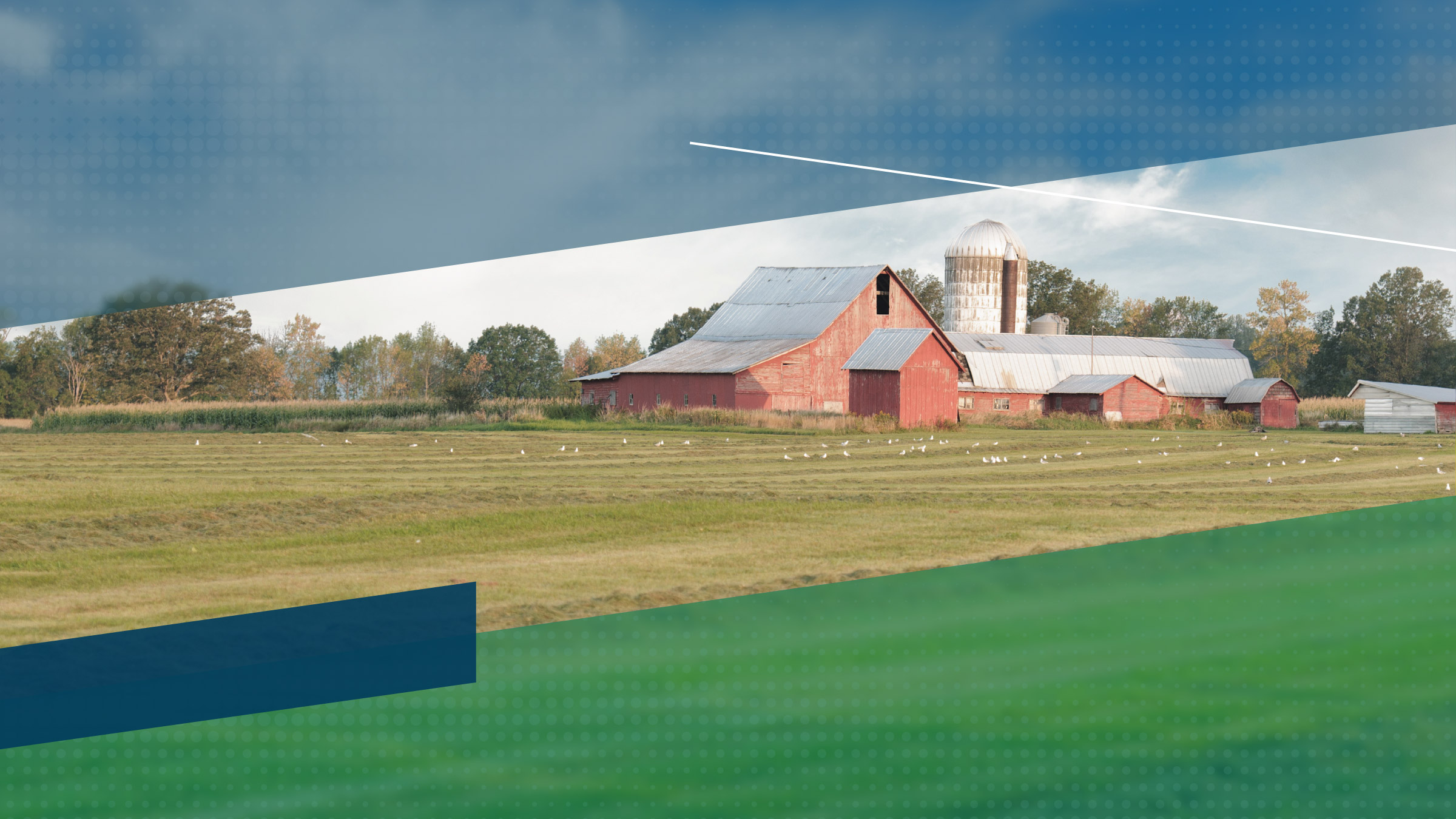Agricultural financial conditions were mixed across the district, according to the results of the Minneapolis Fed's August 2001 agricultural credit survey. Strong agricultural conditions were reported in the Dakotas, while Montana producers faced drought. Meanwhile, dairy country was faring well, while some areas of Minnesota reported that poor weather conditions had affected crops.
Even with the range of conditions across the district, the overall financial performance of the past three months is slightly ahead of last quarter's survey. Producers increased loan repayments and reduced loan extensions. Overall household and capital spending increased slightly from last quarter, and the proportion of farm customers at their debt limit decreased from the second quarter. Meanwhile, interest rates were down from last quarter, while land prices continued to increase.
Farm income and spending
Overall farm income and spending varied significantly across the district. Seventy-one percent and 68 percent of North and South Dakota survey respondents reported average to above-average farm income, respectively. "With calf prices being forward contracted at $1 to $1.10, the economy in South Dakota will be strong," said one South Dakota lender. Meanwhile, 44 percent of Minnesota and 29 percent of Montana lenders reported average to above-average farm income respectively. "Severe drought in our area has caused large production losses in wheat and alfalfa. Also, pasture conditions are poor and cattle producers are going to need to purchase higher priced hay for the winter," said a Montana banker. Chart
Overall farm household spending was stable, as 76 percent of lenders saw average or above-average household spending in the current period. However, 91 percent of South Dakota lenders reported average or above-average household spending compared to 57 percent of Montana lenders. Capital spending remained depressed as only 48 percent of respondents indicated average or above-average capital spending this quarter. Only 29 percent of Montana lenders indicated average or above-average capital spending, compared to 68 percent of South Dakota lenders. Chart
Agricultural Credit Conditions Survey
Third Quarter 2001
| Percent of respondents who reported below normal levels for the past three months | MN | MT | ND | SD | Ninth District |
|---|---|---|---|---|---|
| Rate of loan repayments | 20 |
29 |
7 |
9 |
14 |
| Net farm income | 56 |
71 |
29 |
32 |
45 |
| Farm household spending | 28 |
43 |
21 |
9 |
24 |
| Farm capital spending | 64 |
71 |
50 |
32 |
52 |
| Machinery loans | 48 |
67 |
43 |
36 |
44 |
| Percent of respondents who reported above normal levels for the past three months | MN | MT | ND | SD | Ninth District |
|---|---|---|---|---|---|
| Loan renewals or extensions | 20 |
33 |
7 |
14 |
16 |
| Referrals to other lenders | 13 |
— |
8 |
5 |
7 |
| Amount of collateral required | 12 |
17 |
14 |
23 |
16 |
| Operating loans (excludes feeder loans) | 36 |
— |
29 |
27 |
27 |
|
Note: Wisconsin is omitted from this report due to the small number of survey respondents. The Upper Peninsula of Michigan is not part of the survey. |
Farm loan volumes
Demand for loans remained at normal levels. Livestock and other operating loan volumes were about average over the last three months, as 71 percent and 65 percent of lenders, respectively, reported normal loan demand. Machinery loans and other intermediate-term loans were about average, as 53 percent and 62 percent of lenders, respectively, noted normal loan activity in these two areas. In addition, half the lenders indicated normal real estate loan volumes.
| Agricultural Loan Volumes | ||||
|
Feeder Livestock | Operating | Machinery | Real Estate |
|---|---|---|---|---|
| Significantly higher than normal | 0 % |
3 % |
0 % |
1 % |
| Somewhat higher than normal | 3 % |
24 % |
3 % |
11 % |
| Normal | 71 % |
65 % |
53 % |
50 % |
| Significantly lower than normal | 16 % |
8 % |
34 % |
29 % |
| Somewhat lower than normal | 10 % |
0 % |
10 % |
9 % |
| Percent of respondents, third quarter 2001. | ||||
Bank credit conditions and liquidity
Bank credit conditions and liquidity improved from last quarter. Normal levels of loan repayments were described by 79 percent of lenders, an 11 percentage point increase from last quarter's survey. Normal levels of renewals and extensions were noted as 73 percent of respondents indicated average levels, compared with 68 percent in the second quarter of 2001. "Milk income is strong, which is [the] complete opposite of one year ago. This has led to more rapid repayment of loans and less operating money borrowed," commented a Wisconsin lender. The percentage of farmers at their debt limit edged down to 28 percent compared with 29 percent last quarter. Availability of funds did not seem to be a problem: Only 6 percent of lenders reported refusing to make a loan due to shortage of funds.
| Bank Credit Conditions | ||
|---|---|---|
| Available Funds | Loan Repayment | |
| Significantly higher than normal | 11 % |
0 % |
| Somewhat higher than normal | 14 % |
7 % |
| Normal | 60 % |
79 % |
Significantly lower than normal | 14 % |
13 % |
| Somewhat lower than normal | 1 % |
1 % |
| Percent of respondents, third quarter 2001. | ||
Land values, collateral and interest rates
Cropland prices increased over last fall's prices from an average of 1 percent in North Dakota to 8 percent in Montana and South Dakota. In addition, pasture land price increases ranged from an average of 1 percent in North Dakota to 8 percent in South Dakota over those of a year ago. Collateral levels remained normal, as 84 percent of lenders noted average levels of required collateral. Meanwhile, interest rates for farm loans have decreased over 100 basis points from a year ago.
Outlook
Nearly two-thirds of lenders expected average to above-average farm income during the next three months. "New crop potential is excellent. Record yields will again be expected this year," said a South Dakota banker. However, this varied significantly across the district as 86 percent and 77 percent of North and South Dakota lenders, respectively, expected normal to above-normal profit levels compared to about 43 percent of Minnesota and Montana bankers. The outlook for capital spending was nearly the same: 58 percent of lenders anticipated normal to above-normal levels with similar variability across the district states.
Fixed Interest Rates * |
||||
| Feeder Livestock | Operating | Machinery | Real Estate | |
|---|---|---|---|---|
| 3rd Q '00 | 10.4 |
10.5 |
10.3 |
9.7 |
| 4th Q '00 | 10.3 |
10.4 |
10.3 |
9.6 |
| 1st Q '01 | 9.8 |
9.8 |
9.7 |
9.1 |
| 2nd Q '01 | 9.2 |
9.3 |
9.2 |
8.6 |
| 3rd Q '01 | 8.6 |
8.9 |
9.0 |
8.5 |
* Average of reported rates in mid-August 2001. |
||||
Facts about the survey
Each quarter, the Federal Reserve Bank of Minneapolis surveys agricultural bankers in the Ninth Federal Reserve District, which includes Montana, North Dakota, South Dakota, Minnesota, northwestern Wisconsin and the Upper Peninsula of Michigan. In mid-August, 71 bankers responded regarding conditions during the third quarter 2001.





